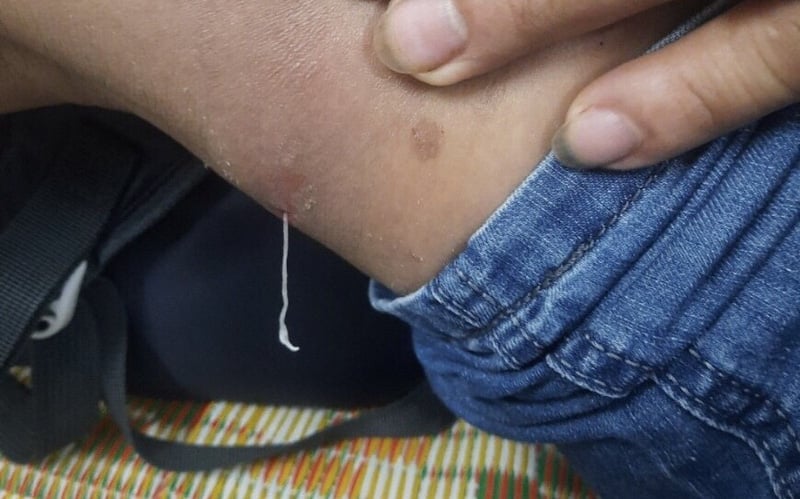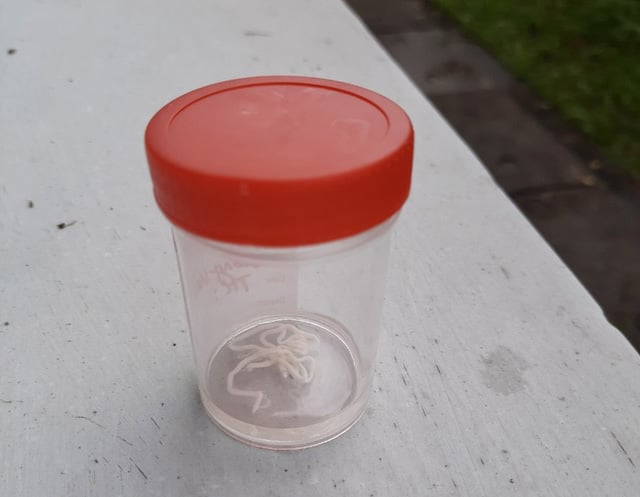A female patient over 40 years old in Thanh Hoa had 6 dragon worms pulled out after she had swelling in her chest, arms, left thigh...
The patient said that when the swelling, pain, rupture, and pus-filled lumps broke open, a white worm was seen crawling out of the damaged area. At the medical facility, the patient was diagnosed with dragon worm infection.
According to Dr. Do Trung Dung, Head of the Department of Parasitology, Central Institute of Malaria - Parasitology - Entomology, in recent years, localities have recorded many patients infected with dragon worms. Dragon worm disease is a disease caused by a type of roundworm ( scientific name is Dracunculus medinensis), parasitic in humans.

Image of worms under the patient's right thigh. Photo: Yen Bai Department of Health
In the world today, each year there are only 20-30 patients infected with dragon worms and mainly in African countries, where living conditions are backward, hygiene is poor, there is no clean water, poverty... These patients often drink water from rivers and streams to get dragon worms.
The World Health Organization (WHO) classifies Guinea worm disease as a neglected tropical disease and is the first parasitic disease to be targeted for global eradication. However, in recent years, the number of cases and the number of countries reporting cases have increased, leading to an outbreak and a resurgence.
From 2019 to now, Vietnam has discovered 15 patients infected with this dragon worm, mainly in Yen Bai and Thanh Hoa provinces... "When we researched carefully, the dragon worm in Vietnam is only similar to the dragon worm that patients in Africa are infected with, but not exactly the same. The World Health Organization also identified this as a new species, not yet in the parasite bank" - Dr. Dung shared.

Many parasite specimens are stored at the Central Institute of Malaria - Parasitology - Entomology.
Epidemiological investigations show that patients with dragon worm disease often drink unboiled river water, eat uncooked caught fish such as frogs, live fish, birds, crabs... These dragon worm larvae often swim in water, clinging to shrimp, crabs, snails, fish, aquatic vegetables...
According to Dr. Dung, when first infected with the disease, there are usually no specific symptoms. About 1 year after contracting the disease, when the worms begin to move and develop in the subcutaneous tissues, the patient may have the following signs: mild fever, dizziness, vomiting, nausea, diarrhea, redness, numbness and itching at the site where the worms are located.
Then the swelling bursts and secretes yellow fluid, at the site of the lesion the worm will crawl up to the skin surface, escaping through the wound. If there is no impact, the worm will usually crawl out completely after a few days to a few weeks, or even a few months.
"The symptoms are usually rash, swelling, heat, redness, pain, forming abscesses and when scratching, scratching through the skin, the worm's head will appear and gradually come out... Some people have worms coming out in the neck, some in the arms, thighs, abdominal wall... The tendency of dragon worms is to come out, so when parasitizing in the human body, they will come out. When worms come out through wounds, it is necessary to catch or pull them out carefully so that the worms are not broken and left in the skin because it can cause infection" - Dr. Dung said.

Image of a dragon worm extracted from a patient at the Yen Bai Provincial Center for Disease Control
According to Dr. Dung, some patients had worms crawl out before they got to the hospital, some took 1-2 weeks to "pull" all the worms out, but some patients had to wait a month to pull them all out. The worms pulled out from the patients were between 0.7 and 1.2 meters long. Some people had 1-2 worms, but others had 5-6 worms.
The most dangerous thing is if this worm enters other locations such as the knees, vertebrae and dies there, causing calcification of the joints and vertebrae, affecting the patient's health.
Through research and evaluation of patients who had had dragon worm disease, Dr. Dung said that in 15 cases, after removing the worms or worms crawling out of the body, most of the worms did not reappear.
Experts recommend that people, especially those in rural and mountainous areas, should not drink unboiled river or stream water, and should not eat uncooked foods (frogs, fish, shrimp, crabs, etc.) because the risk of contracting parasitic diseases is very high.
Source


![[Photo] Closing ceremony of the 18th Congress of Hanoi Party Committee](https://vphoto.vietnam.vn/thumb/1200x675/vietnam/resource/IMAGE/2025/10/17/1760704850107_ndo_br_1-jpg.webp)

























![[Photo] Nhan Dan Newspaper launches “Fatherland in the Heart: The Concert Film”](https://vphoto.vietnam.vn/thumb/1200x675/vietnam/resource/IMAGE/2025/10/16/1760622132545_thiet-ke-chua-co-ten-36-png.webp)











































































Comment (0)